Last week’s book reviews from the International Reading Association's Children’s Literature and Reading Special Interest Group focused on several appealing picture books published during 2012. This week, members of the SIG share their favorite chapter books and nonfiction titles. Many of them are likely to appear on other notable lists announced as the year draws to a close, and even if they don’t, we certainly enjoyed reading them, and are sure the curious readers in your life will too.
Ages 9–11
Burns, Loree Griffin. (2012). Citizen Scientists: Be a Part of Scientific Discovery From Your Own Backyard. Photos by Ellen Harasimowicz. New York: Henry Holt.
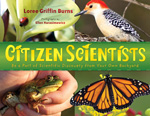 What is a citizen scientist? The book opens with this explanation and encouragement: It involves “the study of our world by the people who live in it. … All men, women and children who use their senses and smarts to understand the world around them can be citizen scientists” (p. 5). Each chapter is divided according to the seasons with suggested kid-friendly projects such as frog counting during the spring, photographing ladybugs during the summer, tagging monarch butterflies during the fall, and counting birds during the winter. Excellent photographs, diagrams, sidebars, and checklists bring this book to life with information and intrigue. Collecting animal data with this hands-on approach gives the research process a life beyond a textbook or the Internet. Readers can take this book a step further with a visit to The National Wildlife Conservation website for the Citizen Scientist Program or explore the author’s Research Trips at her website.
What is a citizen scientist? The book opens with this explanation and encouragement: It involves “the study of our world by the people who live in it. … All men, women and children who use their senses and smarts to understand the world around them can be citizen scientists” (p. 5). Each chapter is divided according to the seasons with suggested kid-friendly projects such as frog counting during the spring, photographing ladybugs during the summer, tagging monarch butterflies during the fall, and counting birds during the winter. Excellent photographs, diagrams, sidebars, and checklists bring this book to life with information and intrigue. Collecting animal data with this hands-on approach gives the research process a life beyond a textbook or the Internet. Readers can take this book a step further with a visit to The National Wildlife Conservation website for the Citizen Scientist Program or explore the author’s Research Trips at her website.
- Karen Hildebrand, Ohio Library & Reading Consultant
Eamer, Claire. (2012). The World in Your Lunch Box. Illus. by Sa Boothroyd. Toronto: Annick Press.
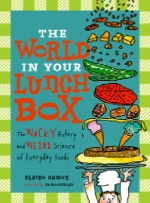 With increased public concern about health, nutrition and childhood obesity, this nonfiction look at the food in kids’ lunch boxes is presented humorously as well as factually. Divided into seven sections for each day of the week, the book explores the history and science behind food and lunch choices and even provides jokes relating to food. Foods typically found in school lunch boxes include watermelon, peanut butter, hot dogs, macaroni, pizza, and ham sandwiches, among others. The author discusses the history behind these foods d and includes interesting anecdotes about these culinary lunch box delights. A detailed downloadable plan for using the author’s lunch box ideas can be found at the publisher’s website.
With increased public concern about health, nutrition and childhood obesity, this nonfiction look at the food in kids’ lunch boxes is presented humorously as well as factually. Divided into seven sections for each day of the week, the book explores the history and science behind food and lunch choices and even provides jokes relating to food. Foods typically found in school lunch boxes include watermelon, peanut butter, hot dogs, macaroni, pizza, and ham sandwiches, among others. The author discusses the history behind these foods d and includes interesting anecdotes about these culinary lunch box delights. A detailed downloadable plan for using the author’s lunch box ideas can be found at the publisher’s website.
- Karen Hildebrand, Ohio Library and Reading Consultant
Palacio, R. J. (2012). Wonder. New York: Knopf Books for Young Readers.
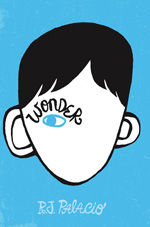 This wonder-filled title told in multiple voices follows a brave fifth grader’s decision to attend school even though he knows that he will face harassment because of his facial deformities. Although Auggie Pullman has been homeschooled all his life, his mother is convinced that face to face classes will allow him to socialize with others and challenge him academically. Two classmates, Summer and Jack, befriend Auggie, but most of the others avert their eyes or avoid him and even play a game of Plague in which anyone who touches Auggie has thirty seconds in which to wash their hands. While Auggie's bravery is unquestionable, so are the courageous acts of his friends, classmates, and family members. Teacher Mr. Browne's precepts serve as excellent life lessons, encouraging acts of kindness and reminding his students to take care of others rather than focusing on themselves. By painting Auggie's older sister realistically, the author allows her to show a human side through which she resents the attention given to her brother and longs for a fresh start unrelated to her brother. Impressively, this novel allows its characters to rise to the occasion so that their heroic sides are revealed. The book will have a positive impact on readers, reminding them of how quickly we judge others based on appearance or what we think we know about them. Once again, readers are reminded that assumptions lead to misunderstandings and distances. How many wonders do we miss by not giving others who seem different from us a chance? Read more about the author in "5 Questions With... R.J. Palacio" on the Engage blog.
This wonder-filled title told in multiple voices follows a brave fifth grader’s decision to attend school even though he knows that he will face harassment because of his facial deformities. Although Auggie Pullman has been homeschooled all his life, his mother is convinced that face to face classes will allow him to socialize with others and challenge him academically. Two classmates, Summer and Jack, befriend Auggie, but most of the others avert their eyes or avoid him and even play a game of Plague in which anyone who touches Auggie has thirty seconds in which to wash their hands. While Auggie's bravery is unquestionable, so are the courageous acts of his friends, classmates, and family members. Teacher Mr. Browne's precepts serve as excellent life lessons, encouraging acts of kindness and reminding his students to take care of others rather than focusing on themselves. By painting Auggie's older sister realistically, the author allows her to show a human side through which she resents the attention given to her brother and longs for a fresh start unrelated to her brother. Impressively, this novel allows its characters to rise to the occasion so that their heroic sides are revealed. The book will have a positive impact on readers, reminding them of how quickly we judge others based on appearance or what we think we know about them. Once again, readers are reminded that assumptions lead to misunderstandings and distances. How many wonders do we miss by not giving others who seem different from us a chance? Read more about the author in "5 Questions With... R.J. Palacio" on the Engage blog.
- Barbara A. Ward, Washington State University Pullman
Pennypacker, Sara. (2012). Summer of the Gypsy Moths. New York: Balzer + Bray.
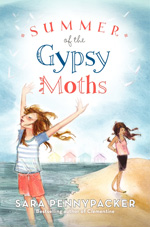 The book’s cover may remind readers of the Clementine series written by the same author, but her latest book, set during a summer on Cape Cod, is quite different from that series and puts the book characters into a more somber setting. Told in the voice of abandoned 11-year-old Stella, whose mother’s location and life is nowhere to be found, the book describes how she has come to live with her great-aunt Louise. Louise has also taken in another foster child, Angel, who is anything but what her name implies. From the onset, the two girls don’t get along. When Louise has a heart attack and dies, the girls are distraught to have lost Louise, but their previous experiences with government authorities compel them to bury Louise in the garden and tell no one about her death. They convince themselves that they can continue to do the housekeeping and odd jobs for the Linger Longer Cottage Colony on Cape Cod that kept great-aunt Louise employed. They especially need to fool George Nickerson, the owner of the cottages for whom Louise had been employed. The girls develop a new lifestyle for themselves in order to continue to live on Cape Cod and also learn the meaning of family, from the traditional families they observe on Cape Cod to the new family arrangement they have carved out for them to survive. The difficulties, including hunger and bills, compound as the summer moves along. The caretakers that come into the girls’ lives to conclude the book may surprise some readers. Well-developed dialogue brings Stella and Angel to life on many levels and makes the book a special summer read for all year long. A discussion guide can be found at the publisher’s website.
The book’s cover may remind readers of the Clementine series written by the same author, but her latest book, set during a summer on Cape Cod, is quite different from that series and puts the book characters into a more somber setting. Told in the voice of abandoned 11-year-old Stella, whose mother’s location and life is nowhere to be found, the book describes how she has come to live with her great-aunt Louise. Louise has also taken in another foster child, Angel, who is anything but what her name implies. From the onset, the two girls don’t get along. When Louise has a heart attack and dies, the girls are distraught to have lost Louise, but their previous experiences with government authorities compel them to bury Louise in the garden and tell no one about her death. They convince themselves that they can continue to do the housekeeping and odd jobs for the Linger Longer Cottage Colony on Cape Cod that kept great-aunt Louise employed. They especially need to fool George Nickerson, the owner of the cottages for whom Louise had been employed. The girls develop a new lifestyle for themselves in order to continue to live on Cape Cod and also learn the meaning of family, from the traditional families they observe on Cape Cod to the new family arrangement they have carved out for them to survive. The difficulties, including hunger and bills, compound as the summer moves along. The caretakers that come into the girls’ lives to conclude the book may surprise some readers. Well-developed dialogue brings Stella and Angel to life on many levels and makes the book a special summer read for all year long. A discussion guide can be found at the publisher’s website.
- Karen Hildebrand, Ohio Library and Reading Consultant
Stead, Rebecca. (2012). Liar & Spy. New York: Wendy Lamb/Random House.
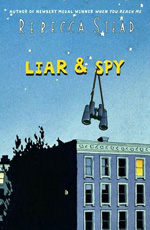 In September Georges’ every-day-after-school friend, Jason, begins to ignore him and sit with the cool students at lunch. After moving into a new apartment building with his parents, Georges attends a “Spy Club” meeting and becomes friends with a twelve-year-old boy named Safer and his sister Candy. Together they begin to spy on Mr. X, a tenant in the same building, who is definitely up to something evil. They use different spy equipment to track when Mr. X enters and leaves the building such as a lobbycam and gum wrappers. When Safer insists that they break and enter into Mr. X’s apartment, Georges has to determine if he really is a friend. While this mystery is unfolding, Georges is dealing with school bullies, learning about the senses in science and playing capture the flag in P.E. Throughout the novel Georges and one of his parents communicate through Scrabble-tile messages. Reminiscent of Stead’s earlier novel When You Reach Me (2009), signs, suspicions and uncertainties are explained in the end. Intermediate students will definitely enjoy this funny mystery.
In September Georges’ every-day-after-school friend, Jason, begins to ignore him and sit with the cool students at lunch. After moving into a new apartment building with his parents, Georges attends a “Spy Club” meeting and becomes friends with a twelve-year-old boy named Safer and his sister Candy. Together they begin to spy on Mr. X, a tenant in the same building, who is definitely up to something evil. They use different spy equipment to track when Mr. X enters and leaves the building such as a lobbycam and gum wrappers. When Safer insists that they break and enter into Mr. X’s apartment, Georges has to determine if he really is a friend. While this mystery is unfolding, Georges is dealing with school bullies, learning about the senses in science and playing capture the flag in P.E. Throughout the novel Georges and one of his parents communicate through Scrabble-tile messages. Reminiscent of Stead’s earlier novel When You Reach Me (2009), signs, suspicions and uncertainties are explained in the end. Intermediate students will definitely enjoy this funny mystery.
- Deanna Day, Washington State University Vancouver
Applegate, Katherine. (2012). The One and Only Ivan. New York: HarperCollins.
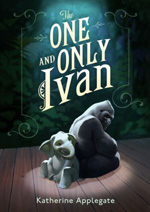 Silverback gorilla Ivan has lived in a small cage in a circus-themed mall in Washington State for most of his life. He spends his days watching television, painting, and chatting with Stella, his elephant friend, and Bob, a tiny dog that survived being tossed from a truck onto the freeway. When Ruby, a baby elephant, joins the other animals, Stella persuades Ivan that he must find a way to save her from living the rest of her days in a cage. While a zoo is not ideal, it's the best alternative available for Ruby, and Ivan is determined to keep his promise to Stella. By saving her, he saves himself and the other animals as well and uncovers long-dormant memories and heroism. Thoughtful readers will be reminded how carelessly we treat other animals and will be relieved when the animals are removed from the custody of Mack, their owner. Many will also wonder why it took so long for anyone to notice the plight of the animals or to care enough to demand that they be given better lives. How many other places like Mack's seedy sideshow exist in the world? Readers are forewarned: This title will tug at your heart and force you to read without stopping except to read for a tissue. Best of all, there really was an Ivan who lived out the rest of his days in an Atlanta zoo until his death earlier this year. Interested readers can view a clip of Ivan and learn more at the Zoo Atlanta website.
Silverback gorilla Ivan has lived in a small cage in a circus-themed mall in Washington State for most of his life. He spends his days watching television, painting, and chatting with Stella, his elephant friend, and Bob, a tiny dog that survived being tossed from a truck onto the freeway. When Ruby, a baby elephant, joins the other animals, Stella persuades Ivan that he must find a way to save her from living the rest of her days in a cage. While a zoo is not ideal, it's the best alternative available for Ruby, and Ivan is determined to keep his promise to Stella. By saving her, he saves himself and the other animals as well and uncovers long-dormant memories and heroism. Thoughtful readers will be reminded how carelessly we treat other animals and will be relieved when the animals are removed from the custody of Mack, their owner. Many will also wonder why it took so long for anyone to notice the plight of the animals or to care enough to demand that they be given better lives. How many other places like Mack's seedy sideshow exist in the world? Readers are forewarned: This title will tug at your heart and force you to read without stopping except to read for a tissue. Best of all, there really was an Ivan who lived out the rest of his days in an Atlanta zoo until his death earlier this year. Interested readers can view a clip of Ivan and learn more at the Zoo Atlanta website.
- Barbara A. Ward, Washington State University Pullman
Ages 12–14
Avi. (2012). Sophia’s War: A Tale of the Revolution. New York: Simon & Schuster/Beach Lane Books.
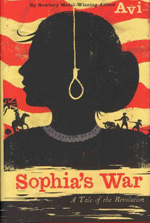 Any teacher who wants students to understand the personal nature of war while experiencing vicariously its hardships and bravery should assign this novel. The story begins in 1776, in New York, when 12-year old Sophia and her mother return home to find their house standing amidst the ruins of many others. Her brother William is away fighting with the Patriots. The British Army has a tight grip over the city, and Sophia and her parents are forced to board British soldiers at their home. Until Sophia sees her brother return to New York as a prisoner, their secret of a Patriot brother is well-kept. Although Sophia hopes that the British soldier they are boarding, John Andre, to whom she is drawn against her will, will help rescue her brother, he does not help, and her brother dies onboard a prison ship. Sophia vows to avenge his death and work for the Patriot cause. Three years later, when is 15 and working as a printer’s apprentice, she becomes a spy. While working as a maid in the house of the British commandant, she uncovers treachery on the part of Andre and one of America’s most respected generals Benedict Arnold. Although the book’s events and its supporting characters are true to life, the character of Sophia Calderwood is completely fictitious. The first person narrative is gripping and presents Sophia’s innermost thoughts to readers. Interested readers can learn more at http://www.avi-writer.com/blog/tag/sophias-war/ and http://www.avi-writer.com/books/books/sophia.html.
Any teacher who wants students to understand the personal nature of war while experiencing vicariously its hardships and bravery should assign this novel. The story begins in 1776, in New York, when 12-year old Sophia and her mother return home to find their house standing amidst the ruins of many others. Her brother William is away fighting with the Patriots. The British Army has a tight grip over the city, and Sophia and her parents are forced to board British soldiers at their home. Until Sophia sees her brother return to New York as a prisoner, their secret of a Patriot brother is well-kept. Although Sophia hopes that the British soldier they are boarding, John Andre, to whom she is drawn against her will, will help rescue her brother, he does not help, and her brother dies onboard a prison ship. Sophia vows to avenge his death and work for the Patriot cause. Three years later, when is 15 and working as a printer’s apprentice, she becomes a spy. While working as a maid in the house of the British commandant, she uncovers treachery on the part of Andre and one of America’s most respected generals Benedict Arnold. Although the book’s events and its supporting characters are true to life, the character of Sophia Calderwood is completely fictitious. The first person narrative is gripping and presents Sophia’s innermost thoughts to readers. Interested readers can learn more at http://www.avi-writer.com/blog/tag/sophias-war/ and http://www.avi-writer.com/books/books/sophia.html.
- Rani Iyer, Washington State University Pullman
Bauer, Joan. (2012). Almost Home. New York: Viking.
 Blessed with an irrepressible spirit and the gift of self-expression, sixth grader Sugar Mae Cole needs that positive outlook on life since her mother, Reba, is on a downward spiral. But it's hard to maintain that sunny outlook after she and her mother are evicted from their home after her absentee father fails to repay money he borrowed and her mother, Reba, loses her job. Mr. Leeland, her father, is prone to gambling away any money he has, but still, the ever-hopeful Reba continues to stand by her man. As Sugar and Reba bounce from place to place, things get worse and worse, and Sugar ends up in a foster home. The scenes in which Reba prepares hopefully for a move to Chicago for a possible job that never pans out are painful to read, vivid reminders of how close each of us might be to being homeless and on our own, isolated in a strange city with no resources other than digits for a phone number that has been disconnected. The author captures perfectly Sugar's voice, her unrelenting optimism and her affection for Shush, the abused puppy she befriends. As she often does with all of her female protagonists, Bauer creates in Sugar a resilient character surrounded by supportive adults, including her former teacher Mr. Bennett who encourages her to express her feelings through writing. The family’s time in homeless shelters is not sugarcoated, with descriptions of the constant waiting in line and lack of privacy there. Desperate as Sugar's situation is at times, each page in this book contains glimmers of hope that things will get better. There are surely more Sugars out there than most of us can imagine, many of them hiding in plain sight. Joan Bauer will be the featured guest at the Young Adult Literature Luncheon on Sunday, April 21, at the IRA Annual Convention in San Antonio, TX.
Blessed with an irrepressible spirit and the gift of self-expression, sixth grader Sugar Mae Cole needs that positive outlook on life since her mother, Reba, is on a downward spiral. But it's hard to maintain that sunny outlook after she and her mother are evicted from their home after her absentee father fails to repay money he borrowed and her mother, Reba, loses her job. Mr. Leeland, her father, is prone to gambling away any money he has, but still, the ever-hopeful Reba continues to stand by her man. As Sugar and Reba bounce from place to place, things get worse and worse, and Sugar ends up in a foster home. The scenes in which Reba prepares hopefully for a move to Chicago for a possible job that never pans out are painful to read, vivid reminders of how close each of us might be to being homeless and on our own, isolated in a strange city with no resources other than digits for a phone number that has been disconnected. The author captures perfectly Sugar's voice, her unrelenting optimism and her affection for Shush, the abused puppy she befriends. As she often does with all of her female protagonists, Bauer creates in Sugar a resilient character surrounded by supportive adults, including her former teacher Mr. Bennett who encourages her to express her feelings through writing. The family’s time in homeless shelters is not sugarcoated, with descriptions of the constant waiting in line and lack of privacy there. Desperate as Sugar's situation is at times, each page in this book contains glimmers of hope that things will get better. There are surely more Sugars out there than most of us can imagine, many of them hiding in plain sight. Joan Bauer will be the featured guest at the Young Adult Literature Luncheon on Sunday, April 21, at the IRA Annual Convention in San Antonio, TX.
- Barbara A. Ward, Washington State University Pullman
Ellis, Deborah. (2012). My Name is Parvana. Toronto, ON: Groundwood Books/House of Anansi Press.
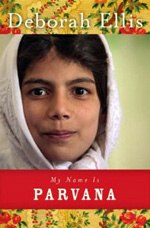 This riveting sequel to the Breadwinner series continues Parvana’s journey after foreign countries defeat the Taliban in Afghanistan. Written in a captivating manner, two stories are conveyed and later connected. In one story, Parvana is being interrogated by foreigners and held in a jail cell. The other story discusses a girls’ school where Parvana’s mother is headmistress, sister Nooria is a teacher and Parvana and her siblings attend to learn. During her captivity, Parvana is able to send her mind somewhere else, ignoring the questioning by reciting multiplication facts. She devours books from a Major and Corporal and suggests that MREs have poems on the packaging. When the base is attacked, a young soldier cries uncontrollably underneath her cell window, and in an act similar to the window woman in the first book in this series, she reaches out to him. Although Parvana’s family was helping rebuild Afghanistan by educating young girls, some of those around them prefer tradition over progress. Even though the Prophet Muhammad says in the Holy Qur’an that all are called to be educated, women and men alike, the old system of beliefs and values continues. Although young fans of Parvana and this series will be satisfied to discover what happens to Parvana and her family, this could easily be a stand-alone book. By purchasing this amazing book, readers will help support education projects for Afghan women and children. To learn more about the author, read this Deborah Ellis Reading Today Online interview from this spring.
This riveting sequel to the Breadwinner series continues Parvana’s journey after foreign countries defeat the Taliban in Afghanistan. Written in a captivating manner, two stories are conveyed and later connected. In one story, Parvana is being interrogated by foreigners and held in a jail cell. The other story discusses a girls’ school where Parvana’s mother is headmistress, sister Nooria is a teacher and Parvana and her siblings attend to learn. During her captivity, Parvana is able to send her mind somewhere else, ignoring the questioning by reciting multiplication facts. She devours books from a Major and Corporal and suggests that MREs have poems on the packaging. When the base is attacked, a young soldier cries uncontrollably underneath her cell window, and in an act similar to the window woman in the first book in this series, she reaches out to him. Although Parvana’s family was helping rebuild Afghanistan by educating young girls, some of those around them prefer tradition over progress. Even though the Prophet Muhammad says in the Holy Qur’an that all are called to be educated, women and men alike, the old system of beliefs and values continues. Although young fans of Parvana and this series will be satisfied to discover what happens to Parvana and her family, this could easily be a stand-alone book. By purchasing this amazing book, readers will help support education projects for Afghan women and children. To learn more about the author, read this Deborah Ellis Reading Today Online interview from this spring.
- Deanna Day, Washington State University Vancouver
Hunter-Gault, Charlayne. (2012). To the Mountaintop: My Journey Through the Civil Rights Movement. New York: Roaring Brook Press.
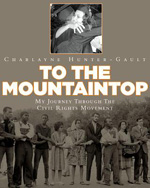 Journalist, NPR foreign correspondent, Emmy and Peabody award winner, author Charlayne Hunter-Gault writes about her life and journey within the civil rights movement. In 1961, Hunter-Gault was one of two students to integrate The University of Georgia in Athens, Georgia. The book opens with the inauguration of President Barack Obama and then begins the chronicle of Hunter-Gault’s life and experiences beginning with her 1959 senior year in high school. Published in association with The New York Times, each chapter opens with headlines from The Times representing the political atmosphere at the time starting with the 1954 “separate but equal” response to overturning Brown vs. Board of Education. Amid the context of freedom riders, lunch counters, sit-ins, violence, peaceful resistance, the author has chronologically placed herself along the path to freedom and describes her own part in the movement. Timelines, photographs, and extensive bibliographic references are found at the end. For further background information, readers will want to watch this Vimeo video conversation and extensive back matter with Charlayne Hunter-Gault.
Journalist, NPR foreign correspondent, Emmy and Peabody award winner, author Charlayne Hunter-Gault writes about her life and journey within the civil rights movement. In 1961, Hunter-Gault was one of two students to integrate The University of Georgia in Athens, Georgia. The book opens with the inauguration of President Barack Obama and then begins the chronicle of Hunter-Gault’s life and experiences beginning with her 1959 senior year in high school. Published in association with The New York Times, each chapter opens with headlines from The Times representing the political atmosphere at the time starting with the 1954 “separate but equal” response to overturning Brown vs. Board of Education. Amid the context of freedom riders, lunch counters, sit-ins, violence, peaceful resistance, the author has chronologically placed herself along the path to freedom and describes her own part in the movement. Timelines, photographs, and extensive bibliographic references are found at the end. For further background information, readers will want to watch this Vimeo video conversation and extensive back matter with Charlayne Hunter-Gault.
- Karen Hildebrand, Ohio Library and Reading Consultant
Knowles, Jo. (2012). See You at Harry’s. Somerville, MA: Candlewick Press.
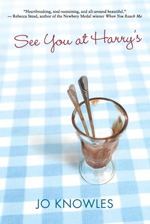 Fern is the twelve-year old member of a family bustling with activity. Her father is totally absorbed in the family restaurant, Harry’s; her mother is often off meditating; her older sister is taking a gap year after high school before setting off to college; her older brother Holden is starting his freshman year in high school and dealing with coming out as gay; and her adorable 3-year old brother, Charlie, although always messy, is the center of the family’s love and attention. Fern’s best friend Ran takes life in stride and reassures Fern that “all will be well” until a terrible accident changes everything. A car hits Charlie while Fern is watching him. The aftermath of this terrible accident brings the harried family together in ways they never imagined. The author’s website offers tips for writing and more.
Fern is the twelve-year old member of a family bustling with activity. Her father is totally absorbed in the family restaurant, Harry’s; her mother is often off meditating; her older sister is taking a gap year after high school before setting off to college; her older brother Holden is starting his freshman year in high school and dealing with coming out as gay; and her adorable 3-year old brother, Charlie, although always messy, is the center of the family’s love and attention. Fern’s best friend Ran takes life in stride and reassures Fern that “all will be well” until a terrible accident changes everything. A car hits Charlie while Fern is watching him. The aftermath of this terrible accident brings the harried family together in ways they never imagined. The author’s website offers tips for writing and more.
- Karen Hildebrand, Ohio Library and Reading Consultant
Levine, Kristen. (2012). The Lions of Little Rock. New York: Putnam Juvenile.
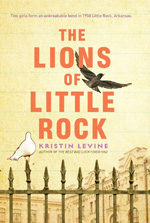 Although the Little Rock Nine had desegregated the public schools of the Arkansas during the previous year, many of the citizens of the town refused to accept the Supreme Court’s ruling, and the high schools were shut down. Some teens were sent to live with other relatives in neighboring towns in order to continue their schooling. In her community school, twelve-year-old Marlee finds friendship in new girl Liz who is as outspoken as Marlee is quiet and helps Marlee overcome her fear of speaking up. But when Liz leaves school amid rumors that she was passing for white, Marlee seeks her out and tries to continue their friendship despite its danger to them and their families. Not only does this book shed light on a little-known part of history in which the community was divided, but it also describes in evocative language the coming of age of a quiet but determined girl whose own courage represents the bravery of the more open-minded members of her own community who choose to do the right thing. Marlee’s habit of describing others through the beverage of which they remind her is an interesting and memorable way of characterizing those she meets.
Although the Little Rock Nine had desegregated the public schools of the Arkansas during the previous year, many of the citizens of the town refused to accept the Supreme Court’s ruling, and the high schools were shut down. Some teens were sent to live with other relatives in neighboring towns in order to continue their schooling. In her community school, twelve-year-old Marlee finds friendship in new girl Liz who is as outspoken as Marlee is quiet and helps Marlee overcome her fear of speaking up. But when Liz leaves school amid rumors that she was passing for white, Marlee seeks her out and tries to continue their friendship despite its danger to them and their families. Not only does this book shed light on a little-known part of history in which the community was divided, but it also describes in evocative language the coming of age of a quiet but determined girl whose own courage represents the bravery of the more open-minded members of her own community who choose to do the right thing. Marlee’s habit of describing others through the beverage of which they remind her is an interesting and memorable way of characterizing those she meets.
- Barbara A. Ward, Washington State University Pullman
Rose, Caroline Starr. (2012). May B. New York: Random House/Schwartz & Wade.
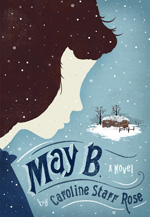 In this novel in verse, because of her family’s financial needs, twelve-year-old May Betterly is sent to work for a newlywed couple on the Kansas frontier. But the Oblingers are having trouble from the start. Try as he might, Mr. Oblinger just can't please his bride who longs for the civilized life in Ohio. When she flees, he, in turn, goes after her but doesn't return. May is left to fend for herself with a limited amount of food and no one nearby to help. At first conscientious about doing her chores, May becomes less and less concerned with them until a blizzard traps her inside the house. The likeable, sympathetic May contends with hunger, boredom, a hungry wolf, and her own personal demons about her inability to read, having been encouraged by one teacher and shamed by another. When she finally makes her way out of the soddy, she knows that she can do anything and has become determined to live—or die—on her own terms. The book’s poetic lines evoke a strong sense of place, allowing readers to savor the prairie’s beauty and feel the bitter cold of the ever-present snow while pausing to admire the pioneer spirit of those who moved westward. By the time May finally opens that can of peaches she's been saving for so long, she knows that she has earned their sweetness. Readers will be forced to put themselves in May’s shoes while imagining what they would have done in her situation.
In this novel in verse, because of her family’s financial needs, twelve-year-old May Betterly is sent to work for a newlywed couple on the Kansas frontier. But the Oblingers are having trouble from the start. Try as he might, Mr. Oblinger just can't please his bride who longs for the civilized life in Ohio. When she flees, he, in turn, goes after her but doesn't return. May is left to fend for herself with a limited amount of food and no one nearby to help. At first conscientious about doing her chores, May becomes less and less concerned with them until a blizzard traps her inside the house. The likeable, sympathetic May contends with hunger, boredom, a hungry wolf, and her own personal demons about her inability to read, having been encouraged by one teacher and shamed by another. When she finally makes her way out of the soddy, she knows that she can do anything and has become determined to live—or die—on her own terms. The book’s poetic lines evoke a strong sense of place, allowing readers to savor the prairie’s beauty and feel the bitter cold of the ever-present snow while pausing to admire the pioneer spirit of those who moved westward. By the time May finally opens that can of peaches she's been saving for so long, she knows that she has earned their sweetness. Readers will be forced to put themselves in May’s shoes while imagining what they would have done in her situation.
- Barbara A. Ward, Washington State University Pullman
Sandler, Martin W. (2012). The Impossible Rescue: The True Story of an Amazing Arctic Adventure. Somerville, MA: Candlewick.
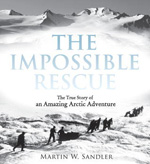 The winter of 1897 comes early, bringing icy water and frozen masses and stranding eight American whaling ships and 300 crewmen and officers. When Captain Benjamin Tilton brings the Alexander to San Francisco with the news, President McKinley is pressured to act to save the men. This incredibly detailed and fascinating book describes the rescue mission that entails bringing three men as far north by sea as possible. They then must make their way across 1,500 miles of frozen terrain while driving two herds of reindeer ahead of them to provide food for the stranded men. As fascinating and improbable as the rescue mission itself is, the descriptions of the deteriorating conditions at Point Barrow where some of the men came ashore are intriguing. Discipline seemed to break down almost as soon as the men left the ships, and keeping the men occupied fell to Charlie Brower, who operated a nearby whaling station, and Ned McIlhenny, a scientist. This fascinating nonfiction title is filled with photographs and accounts of how the indigenous peoples in the area hunted and fished to provide food for the whalers.
The winter of 1897 comes early, bringing icy water and frozen masses and stranding eight American whaling ships and 300 crewmen and officers. When Captain Benjamin Tilton brings the Alexander to San Francisco with the news, President McKinley is pressured to act to save the men. This incredibly detailed and fascinating book describes the rescue mission that entails bringing three men as far north by sea as possible. They then must make their way across 1,500 miles of frozen terrain while driving two herds of reindeer ahead of them to provide food for the stranded men. As fascinating and improbable as the rescue mission itself is, the descriptions of the deteriorating conditions at Point Barrow where some of the men came ashore are intriguing. Discipline seemed to break down almost as soon as the men left the ships, and keeping the men occupied fell to Charlie Brower, who operated a nearby whaling station, and Ned McIlhenny, a scientist. This fascinating nonfiction title is filled with photographs and accounts of how the indigenous peoples in the area hunted and fished to provide food for the whalers.
- Barbara A. Ward, Washington State University Pullman
Wright, Barbara. (2012). Crow. New York: Random House
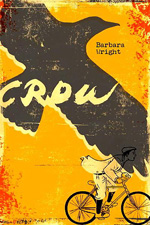 Based on the actual events of the 1898 Wilmington, NC, race riots, this book by debut children’s author is intriguing. Eleven-year-old Moses Thomas is the grandson of a former slave, his Boo Nanny. His mother works for a rich white family, but his Howard University-educated father is an alderman and also a reporter and business manager for The Daily Record, “the only Negro daily newspaper in the South.” Boo Nanny feels Moses needs to learn about life by living it while his father argues that education is the way to succeed in life. After a racially charged incident in town, Moses’ father responds and reacts through his journalism, while white supremacists are spurred into action that results in burning the newspaper office. The historical details provide the background for this story, but the emotional and moral reactions to the events are what make this an unforgettable story. Teachers can use these historical photographs as slides with classes to show what the actual race riots looked like. Extensive resources and lesson plan ideas are available on the author’s website.
Based on the actual events of the 1898 Wilmington, NC, race riots, this book by debut children’s author is intriguing. Eleven-year-old Moses Thomas is the grandson of a former slave, his Boo Nanny. His mother works for a rich white family, but his Howard University-educated father is an alderman and also a reporter and business manager for The Daily Record, “the only Negro daily newspaper in the South.” Boo Nanny feels Moses needs to learn about life by living it while his father argues that education is the way to succeed in life. After a racially charged incident in town, Moses’ father responds and reacts through his journalism, while white supremacists are spurred into action that results in burning the newspaper office. The historical details provide the background for this story, but the emotional and moral reactions to the events are what make this an unforgettable story. Teachers can use these historical photographs as slides with classes to show what the actual race riots looked like. Extensive resources and lesson plan ideas are available on the author’s website.
- Karen Hildebrand, Ohio Library and Reading Consultant
Ages 15+
Carson, Rae. (2012). The Crown of Embers. New York: Greenwillow Books.
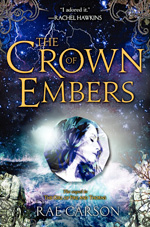 In this sequel to The Girl of Fire and Thorns (2011), Elisa is now Queen of Joya d’Arena, but her life is in danger. Being pressured by her council to remarry soon to build political alliances and yet finding unrest in the kingdom, she is reluctant to rush into a marriage. Even though she thoroughly accepts her responsibilities as ruler, she is also falling in love with her protector, though it is a love than cannot be. As Elisa learns more about her new country and is guided by the pulsating Godstone in her belly, she embarks on a voyage to discover and learn about the zafira, the soul of the world. Her life is threatened at every turn, and the people that surround her have questionable loyalties. Who can she trust? What must she do next? As she works toward these difficult decisions, the enemy Inviernos invade her camp with the aid of a traitor. The end of the book has a cliffhanger that will leave readers anxiously awaiting the end of the trilogy. Readers will want to visit the author’s website to learn more about this planned trilogy. Or they can listen to Chapter One, Part 1 from the audio book. Teachers can look for more fantasy recommendations at ReadWriteThink’s “Feminist Books for Teens.”
In this sequel to The Girl of Fire and Thorns (2011), Elisa is now Queen of Joya d’Arena, but her life is in danger. Being pressured by her council to remarry soon to build political alliances and yet finding unrest in the kingdom, she is reluctant to rush into a marriage. Even though she thoroughly accepts her responsibilities as ruler, she is also falling in love with her protector, though it is a love than cannot be. As Elisa learns more about her new country and is guided by the pulsating Godstone in her belly, she embarks on a voyage to discover and learn about the zafira, the soul of the world. Her life is threatened at every turn, and the people that surround her have questionable loyalties. Who can she trust? What must she do next? As she works toward these difficult decisions, the enemy Inviernos invade her camp with the aid of a traitor. The end of the book has a cliffhanger that will leave readers anxiously awaiting the end of the trilogy. Readers will want to visit the author’s website to learn more about this planned trilogy. Or they can listen to Chapter One, Part 1 from the audio book. Teachers can look for more fantasy recommendations at ReadWriteThink’s “Feminist Books for Teens.”
- Karen Hildebrand, Ohio Library and Reading Consultant
Cashore, Kristin. (2012). Bitterblue. New York: Dial Books.
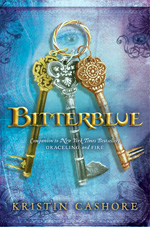 In this companion book to Graceling (2008) and Fire (2009), eight years have passed since the story of Graceling ended and Bitterblue, now eighteen, is the queen of Monsea. The previous ruler, her father King Leck, had been a cruel leader and a sadistic mind controller. When Graceling Katsa killed Leck, few tears were shed at his death. Trying to heal the wounds from the former reign of terror, Bitterblue disguises herself as a peasant and goes out into the city at night to determine their thoughts about how she is ruling the land. Interestingly, two thieves befriend her, and their thoughts and opinions about the kingdom give Bitterblue insight into life within the realm. She learns that many leftover wounds and scars from her father’s horrific reign have not healed nor been corrected. Within the royal household she discovers she does not know whom she can trust and needs to rethink many of the things she has been told. Her life in the castle is fraught with lies, deception, ciphers, spies and thieves who make Bitterblue’s life as sovereign full of confusion and doubt. Like the previous novels, a touch of romance sparks the story, and characters from the earlier novels are intertwined in this novel of palace intrigue. Bitterblue’s development as a queen and ruler forms the basis of the story as she sorts out herself and determines those she can trust. Her goal is to restore the Seven Kingdoms to its former respect and glory and find her niche as its queen. The strong plot makes this adventure fantasy a satisfying conclusion to the Graceling saga. Readers will want to listen to the author read from Bitterblue or enjoy this Facebook page.
In this companion book to Graceling (2008) and Fire (2009), eight years have passed since the story of Graceling ended and Bitterblue, now eighteen, is the queen of Monsea. The previous ruler, her father King Leck, had been a cruel leader and a sadistic mind controller. When Graceling Katsa killed Leck, few tears were shed at his death. Trying to heal the wounds from the former reign of terror, Bitterblue disguises herself as a peasant and goes out into the city at night to determine their thoughts about how she is ruling the land. Interestingly, two thieves befriend her, and their thoughts and opinions about the kingdom give Bitterblue insight into life within the realm. She learns that many leftover wounds and scars from her father’s horrific reign have not healed nor been corrected. Within the royal household she discovers she does not know whom she can trust and needs to rethink many of the things she has been told. Her life in the castle is fraught with lies, deception, ciphers, spies and thieves who make Bitterblue’s life as sovereign full of confusion and doubt. Like the previous novels, a touch of romance sparks the story, and characters from the earlier novels are intertwined in this novel of palace intrigue. Bitterblue’s development as a queen and ruler forms the basis of the story as she sorts out herself and determines those she can trust. Her goal is to restore the Seven Kingdoms to its former respect and glory and find her niche as its queen. The strong plot makes this adventure fantasy a satisfying conclusion to the Graceling saga. Readers will want to listen to the author read from Bitterblue or enjoy this Facebook page.
- Karen Hildebrand, Ohio Library and Reading Consultant
Green, John. (2012). The Fault in Our Stars. New York: Dutton Books.
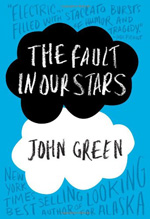 Hazel Lancaster and Gus Waters are teen cancer victims who meet at a cancer support group. Their friendship blossoms into love, and they share each other’s lives as they deal with their cancer. Hazel is particularly drawn to a book, An Imperial Affliction, and invites Gus to read it. Equally enthralled with this novel about cancer, they decide to seek out the author living abroad. A trip to Amsterdam ensues as the young couple finds the American expatriate writer. Brushes with death from their cancer have given this young couple an insight into life that readers will admire. Green tackles this disease head-on, and through Hazel and Gus teens will see how they celebrate the moments that they have together while asking hard questions about what comes next.
Hazel Lancaster and Gus Waters are teen cancer victims who meet at a cancer support group. Their friendship blossoms into love, and they share each other’s lives as they deal with their cancer. Hazel is particularly drawn to a book, An Imperial Affliction, and invites Gus to read it. Equally enthralled with this novel about cancer, they decide to seek out the author living abroad. A trip to Amsterdam ensues as the young couple finds the American expatriate writer. Brushes with death from their cancer have given this young couple an insight into life that readers will admire. Green tackles this disease head-on, and through Hazel and Gus teens will see how they celebrate the moments that they have together while asking hard questions about what comes next.
- Karen Hildebrand, Ohio Library and Reading Consultant
Henry, April. (2012). The Night She Disappeared. New York:Macmillan/Henry Holt/Christy Ottaviano Books.
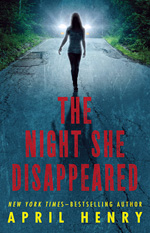 One night Kayla, a Pete’s Pizza delivery girl, goes out to deliver two pizzas and never returns. This disappearance causes coworkers Drew and Gabie to work together to make sense of this tragic event. The chapter titles such as “The Day It Happened” or “The Second Day” help readers understand the timeline of events. In addition, the chapters are brief and told from different perspectives such as Drew, Gabie or other coworkers from the pizza parlor. Interspersed throughout the book are expository writing pieces such as a Pete’s Pizza order form, the 911 transcript call, some police evidence, local newspaper articles and a to-do list. With all of these unique writing examples, along with the suspense and romance, young adolescents will hungrily read this fast-paced novel. At April Henry’s website she shares a video about her life as a mystery writer and describes how she once worked at a pizza parlor.
One night Kayla, a Pete’s Pizza delivery girl, goes out to deliver two pizzas and never returns. This disappearance causes coworkers Drew and Gabie to work together to make sense of this tragic event. The chapter titles such as “The Day It Happened” or “The Second Day” help readers understand the timeline of events. In addition, the chapters are brief and told from different perspectives such as Drew, Gabie or other coworkers from the pizza parlor. Interspersed throughout the book are expository writing pieces such as a Pete’s Pizza order form, the 911 transcript call, some police evidence, local newspaper articles and a to-do list. With all of these unique writing examples, along with the suspense and romance, young adolescents will hungrily read this fast-paced novel. At April Henry’s website she shares a video about her life as a mystery writer and describes how she once worked at a pizza parlor.
- Deanna Day, Washington State University Vancouver
Kokie, E.M. (2012). Personal Effects. Somerville, MA: Candlewick.
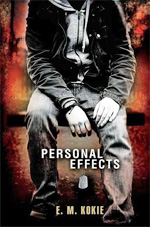 It has been six months since the uniformed officers delivered the personal effects of TJ, Matt Foster’s older brother killed in Iraq. Matt, 17, is struggling not only with the wartime death of his brother but also his violent, former army sergeant father in addition to the abandonment and eventual death of his bi-polar mother years earlier. His father has sealed away the boxes that the military delivered that day, and Matt needs to touch those things to feel closure for his brother’s death. Angry, boiling with turmoil, resentful, Matt lashes out at school toward an anti-war fellow student and beats him unmercifully. This leads to a suspension from school that gives Matt time alone at home. Although he has someone he can talk to and is fully supported by his best friend, Shauna, she is also causing conflict for Matt since his budding feelings for her lean more toward girlfriend than just a friend. When military officials deliver another box of TJ’s personal effects, Matt opens them before his father has a chance to secret them. He discovers letters and an entire hidden life of his brother that Matt had no idea existed. Based on the letters from someone named Celia, Matt decides to journey to Madison, Wisconsin, to deliver one letter from TJ that never got mailed. When he arrives at the home, his eyes are opened to a number of situations that provide new directions for his own personal thoughts and decisions. This heart-wrenching story will resonate with readers long after the book is closed. Readers may want to listen to an interview with this debut author on her website.
It has been six months since the uniformed officers delivered the personal effects of TJ, Matt Foster’s older brother killed in Iraq. Matt, 17, is struggling not only with the wartime death of his brother but also his violent, former army sergeant father in addition to the abandonment and eventual death of his bi-polar mother years earlier. His father has sealed away the boxes that the military delivered that day, and Matt needs to touch those things to feel closure for his brother’s death. Angry, boiling with turmoil, resentful, Matt lashes out at school toward an anti-war fellow student and beats him unmercifully. This leads to a suspension from school that gives Matt time alone at home. Although he has someone he can talk to and is fully supported by his best friend, Shauna, she is also causing conflict for Matt since his budding feelings for her lean more toward girlfriend than just a friend. When military officials deliver another box of TJ’s personal effects, Matt opens them before his father has a chance to secret them. He discovers letters and an entire hidden life of his brother that Matt had no idea existed. Based on the letters from someone named Celia, Matt decides to journey to Madison, Wisconsin, to deliver one letter from TJ that never got mailed. When he arrives at the home, his eyes are opened to a number of situations that provide new directions for his own personal thoughts and decisions. This heart-wrenching story will resonate with readers long after the book is closed. Readers may want to listen to an interview with this debut author on her website.
- Karen Hildebrand, Ohio Library and Reading Consultant
McCormick, Patricia. (2012). Never Fall Down: A Novel. New York: HarperCollins/Balzer + Bray.
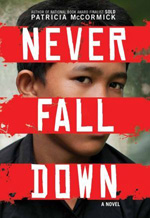 Based on actual events in Cambodia, this book describes how 11-year old Arn Chorn-Pond’s village is overcome by soldiers who march everyone into the country. Arn is separated from his family and soon learns that he and the other children are to be used as slave labor. Survival is tough on many fronts including the constant hunger with only a handful of rice to eat each day. One day the soldiers ask if anyone can play an instrument. Arn, who does not, immediately volunteers and becomes a quick study as he sees this as an opportunity to survive what comes to be known as The Killing Fields of the Khmer Rouge regime, considered one of the worst genocides of the twentieth century. As the war continues, Arn is forced to give up his flute, start carrying a gun and become an actual soldier. Somehow, he survives, eventually making his way to the United States where he is able to tell his story. McCormick, a National Book Award finalist, was interviewed on NPR about the book. This book begs readers to conduct research to learn more about Arn Chorn-Pond. A good starting place can be found at Facing History that includes a video.
Based on actual events in Cambodia, this book describes how 11-year old Arn Chorn-Pond’s village is overcome by soldiers who march everyone into the country. Arn is separated from his family and soon learns that he and the other children are to be used as slave labor. Survival is tough on many fronts including the constant hunger with only a handful of rice to eat each day. One day the soldiers ask if anyone can play an instrument. Arn, who does not, immediately volunteers and becomes a quick study as he sees this as an opportunity to survive what comes to be known as The Killing Fields of the Khmer Rouge regime, considered one of the worst genocides of the twentieth century. As the war continues, Arn is forced to give up his flute, start carrying a gun and become an actual soldier. Somehow, he survives, eventually making his way to the United States where he is able to tell his story. McCormick, a National Book Award finalist, was interviewed on NPR about the book. This book begs readers to conduct research to learn more about Arn Chorn-Pond. A good starting place can be found at Facing History that includes a video.
- Karen Hildebrand, Ohio Library and Reading Consultant
Newman, Leslea. (2012). October Mourning: A Song for Matthew Shepard. Somerville, MA: Candlewick.
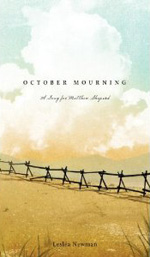 Back in October of 1998 Matthew Shepard, a young gay male, was kidnapped and left for dead outside of Laramie, Wyoming, by two men he met in a bar. This collection of 68 poems from different perspectives provides ruminations on that tragic event. The author examines the thoughts of the fence where Matthew was tied, the rope with which he was bound, the pistol with which he was beaten, even the truck in which he was driven out of town, and the road on which he and his assailants traveled. The stars, the wind, and a pregnant doe who stayed by his side through his lonely ordeal provide sympathetic poems. There are even poems intended to provide insight into the actions of Aaron McKinney and Russell Henderson who left him tied to that fence. Although there are many lines that will make readers weep and shake their heads over the inhumanity of humans, there are also passages that offer hope and celebrate the essential goodness of humankind. Back matter includes notes on each poem, an explanation of the poetic forms the author uses to tell Matthew's story, and a resource list. This is a stunning title that reminds readers of all that was lost when Matthew died and how much energy is misdirected as the result of ignorance, bigotry, and hatred. The author talks about October Mourning in "5 Questions With... Lesléa Newman" on the Engage blog.
Back in October of 1998 Matthew Shepard, a young gay male, was kidnapped and left for dead outside of Laramie, Wyoming, by two men he met in a bar. This collection of 68 poems from different perspectives provides ruminations on that tragic event. The author examines the thoughts of the fence where Matthew was tied, the rope with which he was bound, the pistol with which he was beaten, even the truck in which he was driven out of town, and the road on which he and his assailants traveled. The stars, the wind, and a pregnant doe who stayed by his side through his lonely ordeal provide sympathetic poems. There are even poems intended to provide insight into the actions of Aaron McKinney and Russell Henderson who left him tied to that fence. Although there are many lines that will make readers weep and shake their heads over the inhumanity of humans, there are also passages that offer hope and celebrate the essential goodness of humankind. Back matter includes notes on each poem, an explanation of the poetic forms the author uses to tell Matthew's story, and a resource list. This is a stunning title that reminds readers of all that was lost when Matthew died and how much energy is misdirected as the result of ignorance, bigotry, and hatred. The author talks about October Mourning in "5 Questions With... Lesléa Newman" on the Engage blog.
- Barbara A. Ward, Washington State University Pullman
Rivers, Karen. (2012). The Encyclopedia of Me. New York: Scholastic.
 Eighth grader Tink Aaron-Martin spends most of the summer grounded for various reasons, most of them involving her BFF Freddie Blue. To fill her time, she writes an encyclopedia about her life but also containing interesting side notes about bears, eels, fish, whatever strikes her fancy. The entries trace the bond between Tink and her best friend as it starts to unravel, and Freddie Blue becomes someone Tink no longer recognizes. Readers will enjoy Tink's voice as she addresses her potential readers directly while laughing at many of the references to her school, Cortez, and the gifted students who attend it. As Tink moves toward her first romance with Kai, the skater who moves next door, her family tries for normalcy amid the havoc sometimes caused by her brother Seb's autism. Although most of Tink's experiences are typical for a girl her age, the author describes her so sympathetically that readers will miss her once they reach the last page. She truly is a character worthy of a couple of encyclopedia entries.
Eighth grader Tink Aaron-Martin spends most of the summer grounded for various reasons, most of them involving her BFF Freddie Blue. To fill her time, she writes an encyclopedia about her life but also containing interesting side notes about bears, eels, fish, whatever strikes her fancy. The entries trace the bond between Tink and her best friend as it starts to unravel, and Freddie Blue becomes someone Tink no longer recognizes. Readers will enjoy Tink's voice as she addresses her potential readers directly while laughing at many of the references to her school, Cortez, and the gifted students who attend it. As Tink moves toward her first romance with Kai, the skater who moves next door, her family tries for normalcy amid the havoc sometimes caused by her brother Seb's autism. Although most of Tink's experiences are typical for a girl her age, the author describes her so sympathetically that readers will miss her once they reach the last page. She truly is a character worthy of a couple of encyclopedia entries.
- Barbara A. Ward, Washington State University Pullman
Schrefer, Eliot. (2012). Endangered. New York: Scholastic.
 The Congo to which she returns is not the one fourteen-year-old Sophie Biyoya-Ciardulli remembers from her earlier years there. Her mother runs a bonobo sanctuary there, and right away, she breaks one of her mother’s rules when she buys a bonobo from a man on a bicycle, thus, saving its life. Sophie and the bonobo Otto bond quickly as she works hard to keep him alive. Before she can return home to Miami, chaos disrupts the countryside, and Sophie and Otto depend on each other to survive. At first Sophie hides in the sanctuary's enclosure with the other bonobos after the soldiers come, but eventually, she must venture away from its safety if she and Otto have any chance to survive. While some might argue that Sophie's decision not to leave in the UN van that arrived to take her to safety early in the story was foolish, it is also an act of love, intended to save Otto from certain death. The author provides just enough description of the different bonobos at the sanctuary and the territory through which Sophie ventured to make readers experience her desperation for food, water, and shelter. This book encourages is thoughtful examination of the value of lives, both humans and bonobos, and how helpless anyone can become in the face of something unplanned.
The Congo to which she returns is not the one fourteen-year-old Sophie Biyoya-Ciardulli remembers from her earlier years there. Her mother runs a bonobo sanctuary there, and right away, she breaks one of her mother’s rules when she buys a bonobo from a man on a bicycle, thus, saving its life. Sophie and the bonobo Otto bond quickly as she works hard to keep him alive. Before she can return home to Miami, chaos disrupts the countryside, and Sophie and Otto depend on each other to survive. At first Sophie hides in the sanctuary's enclosure with the other bonobos after the soldiers come, but eventually, she must venture away from its safety if she and Otto have any chance to survive. While some might argue that Sophie's decision not to leave in the UN van that arrived to take her to safety early in the story was foolish, it is also an act of love, intended to save Otto from certain death. The author provides just enough description of the different bonobos at the sanctuary and the territory through which Sophie ventured to make readers experience her desperation for food, water, and shelter. This book encourages is thoughtful examination of the value of lives, both humans and bonobos, and how helpless anyone can become in the face of something unplanned.
- Barbara A. Ward, Washington State University Pullman
Sheinkin, Steve. (2012). Bomb: The Race to Build—and Steal—the World’s Most Dangerous Weapon. New York: Macmillan/FlashPoint.
 Scientists, political leaders and spies – everyone wanted the atomic bomb. It was 1938 when the radioactive uranium atom was split. And so began the race to develop the world’s most destructive bomb – a war-ending bomb. Sheinkin’s well-researched background into the history of the atomic bomb deals not only with the scientific background but reveals the attempts by the Soviets to steal the secret behind the creation of the first atomic bomb. This book travels the world as the history of this era unfolds from the moment the original German scientist made the atomic discovery before moving on to describe how many of those scientists were brought to the United States to work at The University of Chicago and then continuing to the testing grounds in New Mexico. The book is divided into the Prologue, Part 1 – Three-Way Race; Part 2 – Chain Reaction; Part 3 – How to Build an Atomic Bomb; Part 4 – Final Assembly; and concludes with an Epilogue, Race to Trinity and extensive source notes and credits. Photographs are interspersed throughout each chapter to put faces on the many characters that played a part in this real life drama. Readers will be able to learn more about this bomb at the author’s website and learn more about the author's process in "5 Questions With... Steve Sheinkin" on the Engage blog.
Scientists, political leaders and spies – everyone wanted the atomic bomb. It was 1938 when the radioactive uranium atom was split. And so began the race to develop the world’s most destructive bomb – a war-ending bomb. Sheinkin’s well-researched background into the history of the atomic bomb deals not only with the scientific background but reveals the attempts by the Soviets to steal the secret behind the creation of the first atomic bomb. This book travels the world as the history of this era unfolds from the moment the original German scientist made the atomic discovery before moving on to describe how many of those scientists were brought to the United States to work at The University of Chicago and then continuing to the testing grounds in New Mexico. The book is divided into the Prologue, Part 1 – Three-Way Race; Part 2 – Chain Reaction; Part 3 – How to Build an Atomic Bomb; Part 4 – Final Assembly; and concludes with an Epilogue, Race to Trinity and extensive source notes and credits. Photographs are interspersed throughout each chapter to put faces on the many characters that played a part in this real life drama. Readers will be able to learn more about this bomb at the author’s website and learn more about the author's process in "5 Questions With... Steve Sheinkin" on the Engage blog.
- Karen Hildebrand, Ohio Library and Reading Consultant
Wein, Elizabeth. (2012). Code name Verity. New York: Hyperion Books.
 Two young women’s lives become intertwined during World War II. As Maggie, the pilot, and Julia, the spy (“Verity”), become friends, readers learn about their very different backgrounds. In a mission flying over France, their plane crashes, and Julia is captured. The Nazis initiate their torture to get information from their captive about the British War Effort. Trying to delay her impending death and succumbing to the torture, she begins her tale of the crash and her dear friend Maggie. This harsh, riveting story portrays not only the depth of their friendship but the courage displayed by both these young women as they bravely face the consequences of war. The second part of the book tells the story from Maggie’s point of view. A compelling story about war and friendship, this title will keep readers gasping with tear-filled eyes. Readers will want to watch the book trailer and learn more of the back-story at the author’s website.
Two young women’s lives become intertwined during World War II. As Maggie, the pilot, and Julia, the spy (“Verity”), become friends, readers learn about their very different backgrounds. In a mission flying over France, their plane crashes, and Julia is captured. The Nazis initiate their torture to get information from their captive about the British War Effort. Trying to delay her impending death and succumbing to the torture, she begins her tale of the crash and her dear friend Maggie. This harsh, riveting story portrays not only the depth of their friendship but the courage displayed by both these young women as they bravely face the consequences of war. The second part of the book tells the story from Maggie’s point of view. A compelling story about war and friendship, this title will keep readers gasping with tear-filled eyes. Readers will want to watch the book trailer and learn more of the back-story at the author’s website.
- Karen Hildebrand, Ohio Library and Reading Consultant
These reviews are submitted by members of the International Reading Association's Children's Literature and Reading Special Interest Group (CL/R SIG) and are published weekly on Reading Today Online. The International Reading Association partners with the National Council of Teachers of English and Verizon Thinkfinity to produce ReadWriteThink.org, a website devoted to providing literacy instruction and interactive resources for grades K–12.